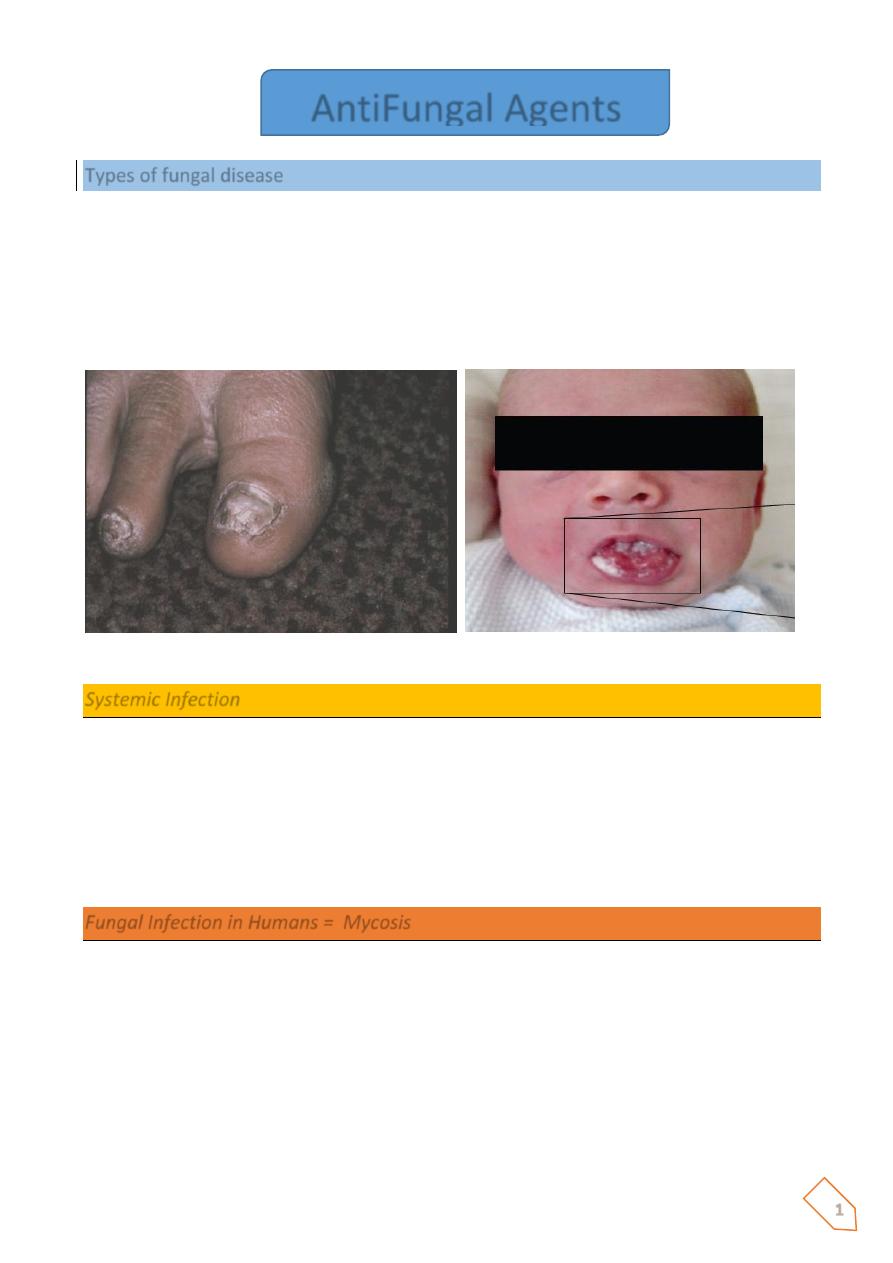
1
Types of fungal disease
ⱴ
Skin infections
: e.g. foot fungus (usually smelly but not life threatening, sometimes
becomes serious), ring worm
ⱴ
Mucosal infections
: oral or vaginal (range from annoying to painful to very difficult;
uncomfortable but rarely life threatening)
ⱴ
Systemic infections
: fungus in the blood and tissues (immunocompromised population,
usually life threatening)
Onychomycosis: foot fungus Oral Candidiasis
Systemic Infection
ⱴ Susceptible population: abdominal surgery, cancer chemotherapy, bone marrow
transplant, organ transplants, other immunotherapy, other immunecompromising
disease
ⱴ High mortality: those people that get systemic infection are already sick; current
drugs are not effective
Fungal Infection in Humans = Mycosis
Major Types of Mycoses
ⱴ superficial
ⱴ cutaneous
ⱴ subcutaneous
ⱴ systemic
ⱴ opportunistic
Symptoms vary from cosmetic to life threatening
AntiFungal Agents
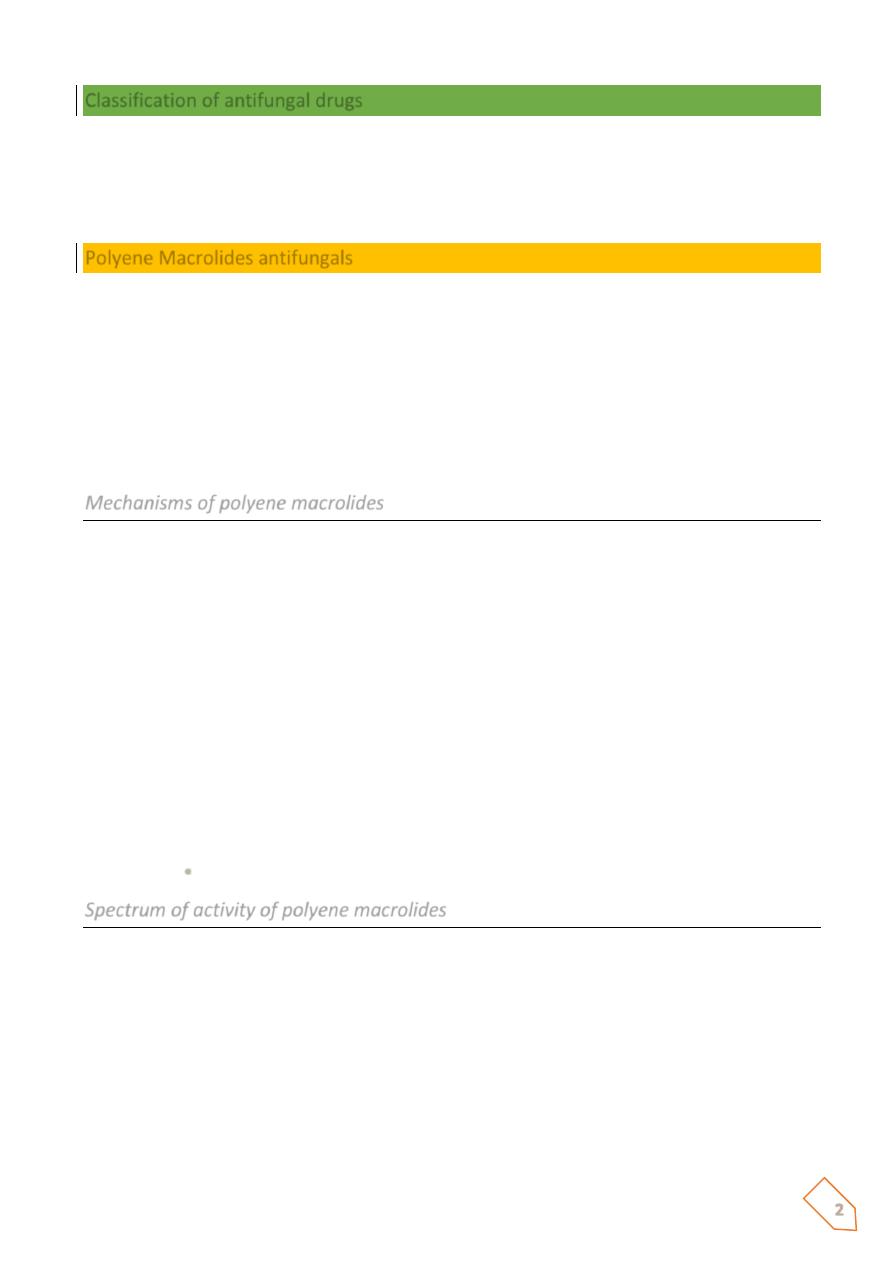
2
Classification of antifungal drugs
Based on chemical structures: The classes include
Polyene macrolides, Imidazoles, Fluorinated pyrimidines, Benzo-furans and Iodides
Based on their sites of action: Either systemic or topical antifungal drugs.
Miscellaneous classifications: Organic acids and their salts and other inorganic salts
Polyene Macrolides antifungals
• Polyene macrolides antifungals were isolated from
ⱴ various species of Streptomyces.
• Examples used in veterinary medicine include;
ⱴ Amphotericin B,
ⱴ Nystatin
ⱴ Pimaricin (natamycin)
Mechanisms of polyene macrolides
ⱴ Polyene macrolides bind to sterols (ergosterol) in the cell membrane of susceptible
fungi.
ⱴ This creates a transmembrane channel, changing membrane permeability and thus
allowing leakage of intracellular components.
ⱴ In particular, amphotericin B binds to ergosterol in fungal membranes disrupting its
function leading to K+ ion efflux and H+ ion influx.
Consequently, internal acidification of fungal cell occurs and thus stopping enzymatic
functions. Sugars and amino acids also leak from an arrested cell.
For Natamycin, the binding to ergosterol in the plasma membrane, prevents ergosterol-
dependent fusion of vacuoles, as well as membrane fusion and fission.
This differs from the mechanism of amphotericin B, which alters fungal membrane
permeability.
Spectrum of activity of polyene macrolides
o They have broad antifungal activity including filamentous fungi, saprophytic and
pathogenic fungi.
o Amphotericin B is effective against Coccidiomycosis, histoplasmosis, candidiasis
and blastomycosis.
o Nystatin is effective against candidiasis against, other yeasts and fungi.
o Pimaricin is effective against candidiasis trichomoniasis and mycotic keratitis
(dermatophytes).
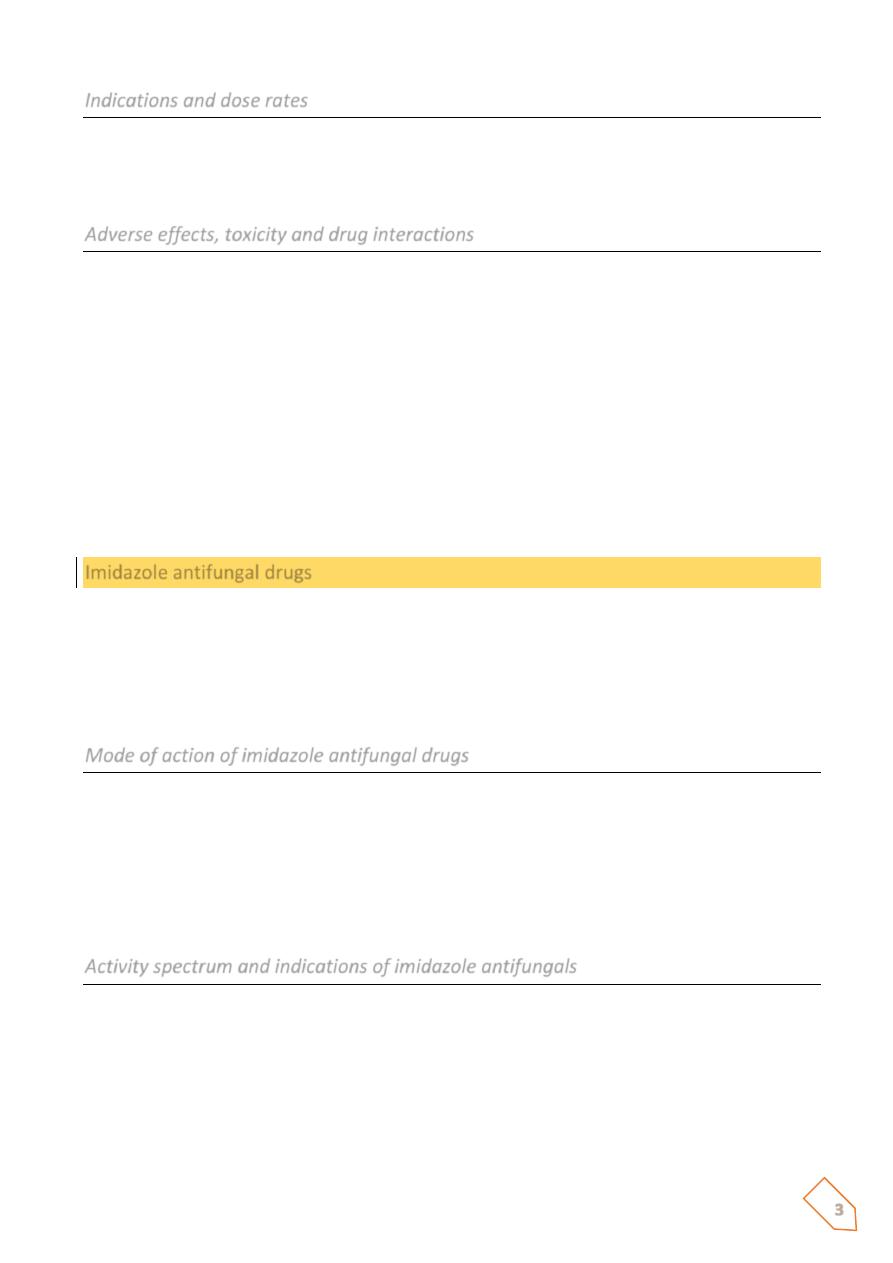
3
Indications and dose rates
o Amphotericin B is used for the treatment of systemic mycotic infections.
o Nystatin is indicated for the treatment of mucocutaneous or intestinal candidiasis.
o Pimaricin is used in therapeutic management of mycotic keratitis.
Adverse effects, toxicity and drug interactions
• Oral administration of nystatin can lead to anorexia and GIT disturbances
• Amphotericin B may cause nephrotoxicity after IV infusion. The drug may also cause
anorexia, nausea, vomiting, hypersensitivity and drug fever.
• Rifampin may potentiate the amphotericin B activity.
• Amphotericin B should be contraindicated during therapy with aminoglycosides
(nephrotoxicity)
The drug should not administered with digitalis drugs (increased toxicity), and neuromuscular
blocking drugs.
It should be avoided when mineralocorticoids, thiazide diuretics, antineoplastic drugs, and
cyclosporine have been used.
Imidazole antifungal drugs
ⱴ Imidazoles antifungals contains imidazole ring in their chemical structures.
ⱴ Some imidazoles also have antibacterial, antifungal, antiprotozoal, and anthelmintic
activity.
ⱴ Examples of imidazole derivatives used as antifungals are; clotrimazole, miconazole,
econazole, ketoconazole, itraconazole, and fluconazole.
Mode of action of imidazole antifungal drugs
ⱴ Imidazoles block the synthesis of ergosterol, the primary cell sterol of fungi thereby
altering the cell membrane permeability of yeasts and fungi.
ⱴ They also impair enzymes required for fatty acid synthesis and also cause toxic
concentrations of hydrogen peroxide to develop intracellularly due to changes in
oxidative and peroxidative enzyme activities.
ⱴ This results in cell membrane and internal organelle disruption and cell death.
Activity spectrum and indications of imidazole antifungals
• Miconazole has a wide antifungal spectrum against most fungi and yeasts of veterinary
interest.
• Ketoconazole is more effective against C immitis and some other yeasts and fungi.
• Itraconazole and fluconazole are active against dimorphic fungal organisms and
dermatophytes.
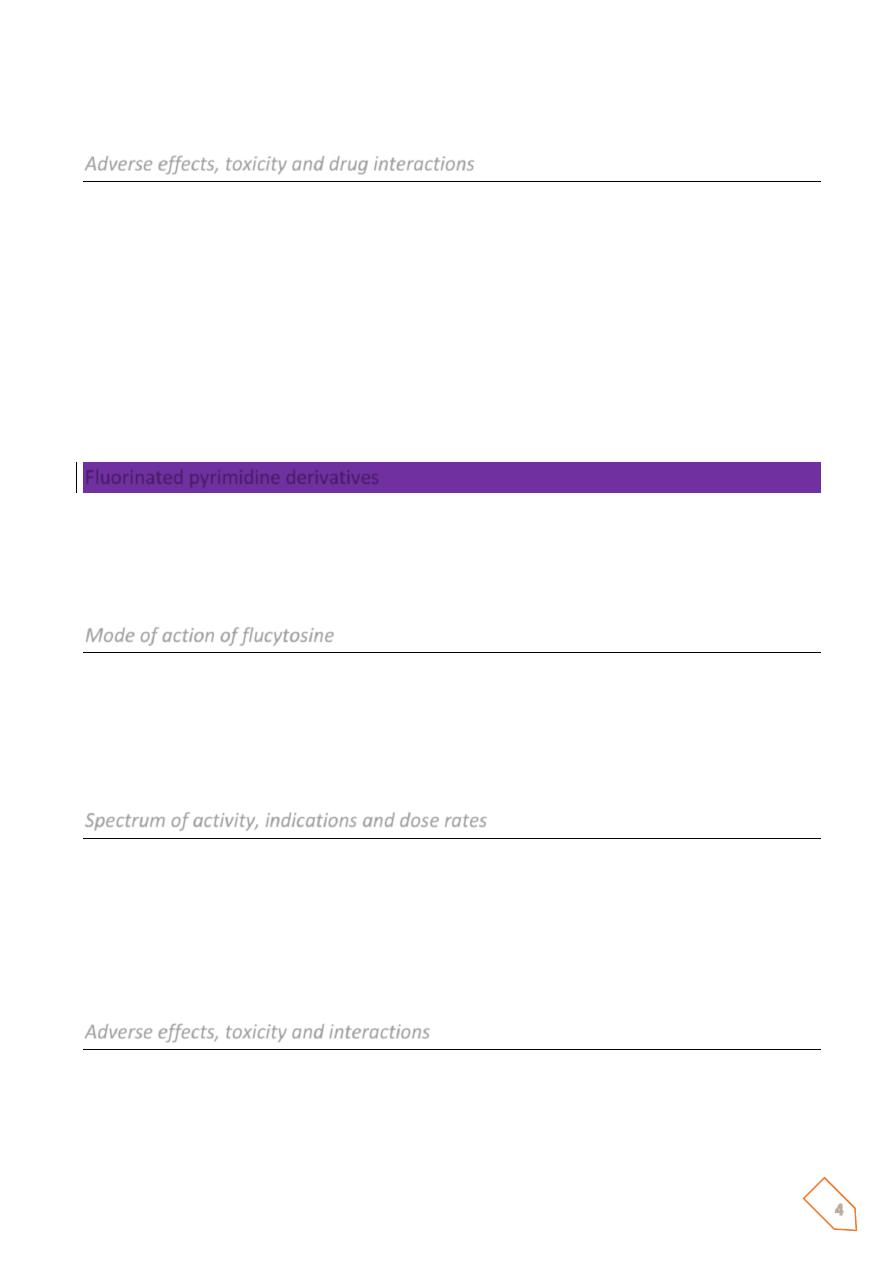
4
• Clotrimazole and econazole are used for superficial mycoses (dermatophytosis and
candidiasis);
Adverse effects, toxicity and drug interactions
• Ketoconazole given orally may result in nausea, vomiting, and hepatic dysfunction, as
well as altered testosterone and cortisol metabolism.
• Reproductive disorders related to ketoconazole administration may be seen in dogs.
• Voriconazole is associated with a number of adverse effects in humans, including vision
disturbances.
• The imidazoles may be used concurrently with amphotericin B or 5-flucytosine to
potentiate its antifungal activity.
• The absorption of the imidazoles, (except for that of fluconazole), is inhibited by
concurrent administration of cimetidine, ranitidine, anticholinergic agents, or gastric
antacids.
Fluorinated pyrimidine derivatives
• This antifungal drug includes fluorinated pyrimidine cytosine analog that is related to
fluorouracil.
• Example includes flucytosine (5-fluorocytosine)
• The drug was initially developed as an antineoplastic agent.
Mode of action of flucytosine
• Flucytosine is converted by cytosine deaminase in fungal cells to fluorouracil, which
interferes with RNA and protein synthesis.
• Fluorouracil is metabolized to 5-fluorodeoxyuridylic acid, which inhibits thymidylate
synthetase required for DNA synthesis.
• These effects eventually inhibits DNA synthesis and may cause fungal cell deaths.
Spectrum of activity, indications and dose rates
• Flucytosine is effective against Cryptococcus neoformans, Candida albicans,
Phialophora and Cladosporium spps.
• The common indications for flucytosine are cryptococcal meningitis, used together
with amphotericin B.
• General dosages are 25–50 mg/kg and 30–40 mg/kg, orally 4 times a day in dogs and
cats, respectively.
Adverse effects, toxicity and interactions
• Flucytosine is toxic at high doses and leads to nausea, vomiting, and diarrhea.
• It causes reversible increased liver enzymes, anemia, neutropenia, thrombocytopenia).
• The renal effects of amphotericin B prolong elimination of flucytosine.
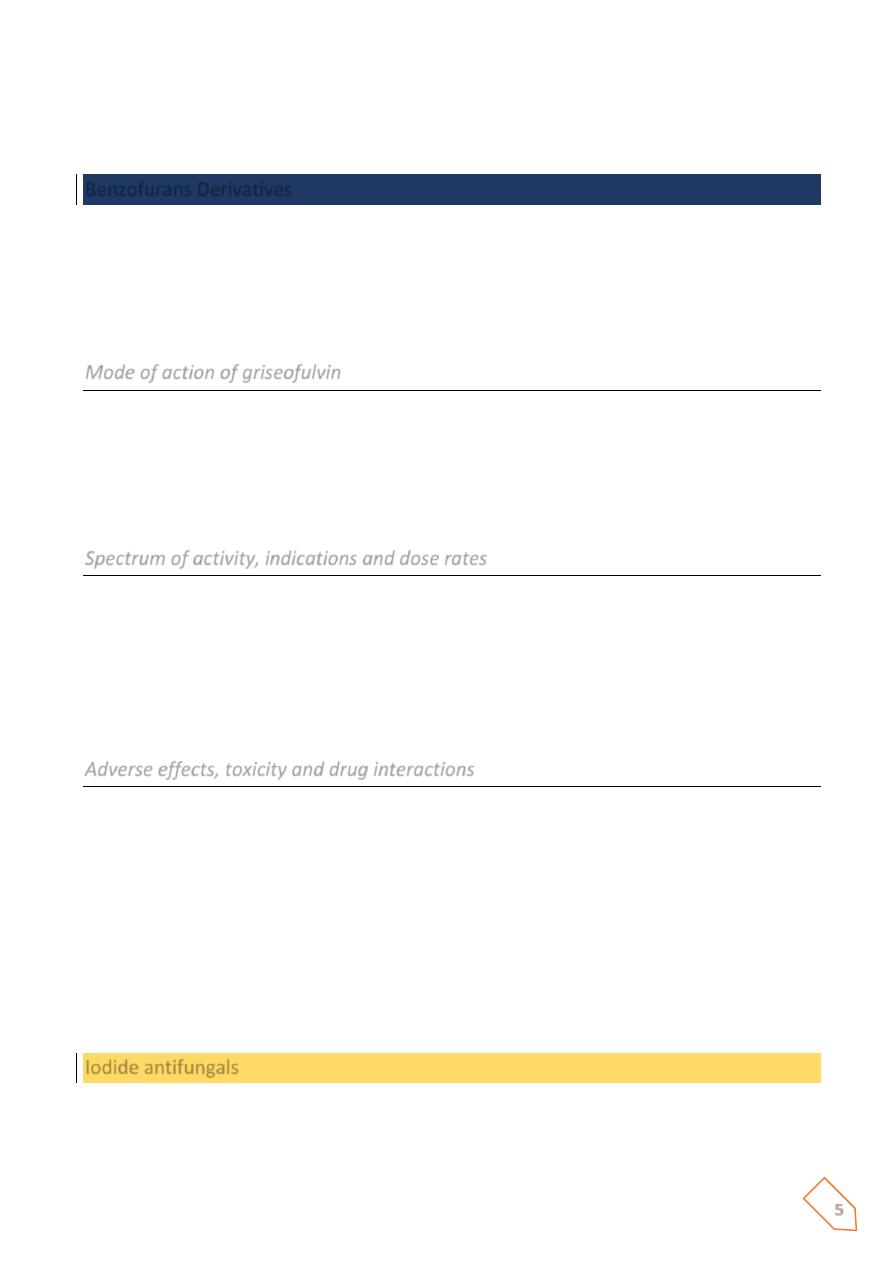
5
• If flucytosine is combined with immunosuppressive drugs, depression of bone marrow
function is possible.
23
Benzofurans Derivatives
• Benzofuran derivative includes Griseofulvin which is fungistatic but is fungicidal for
young active cells.
• Griseofulvin accumulates in the stratum corneum and is highly effective against the
dermatophytes.
• Dermatophytes are resistant to griseofulvin in vitro.
Mode of action of griseofulvin
• Griseofulvin disrupts the mitotic spindle by interactingwith the polymerized
microtubules in susceptible dermatophytes.
• This results in the production of multinucleate fungal cells. The drug also acts by
inhibiting nucleic acid synthesis and forms hyphal cell wall material.
• This results in distortion, irregular swelling, and spiral curling of the hyphae.
Spectrum of activity, indications and dose rates
• Griseofulvin is active against Microsporum, Epidermophyton, and Trichophyton spp.
• Indicated for infections in dogs, cats, calves, horses, and other domestic and exotic
animal species.
• Dogs and cats the dose rate is 10-30 or 130mg/Kg orally single dose or divided twice or
three times per day.
• Horses and cattle the dose rate is 5-10 mg/Kg orally.
Adverse effects, toxicity and drug interactions
• Adverse effects induced by griseofulvin but nausea, vomiting, diarrhea and
hepatotoxicity may be seen.
• Griseofulvin is contraindicated in pregnant mares and queens because it is teratogenic.
• Lipids increase the GI absorption of griseofulvin.
Barbiturates decrease absorption and antifungal activity of Griseofulvin.
Griseofulvin is a microsomal enzyme inducer and promotes the biotransformation of
concurrently administered drugs.
The combined use of ketoconazole and griseofulvin may lead to hepatotoxicity
Iodide antifungals
• Sodium and potassium iodide are used to treat selected bacterial, actinomycete, and
fungal infections with sodium iodide being preferred.
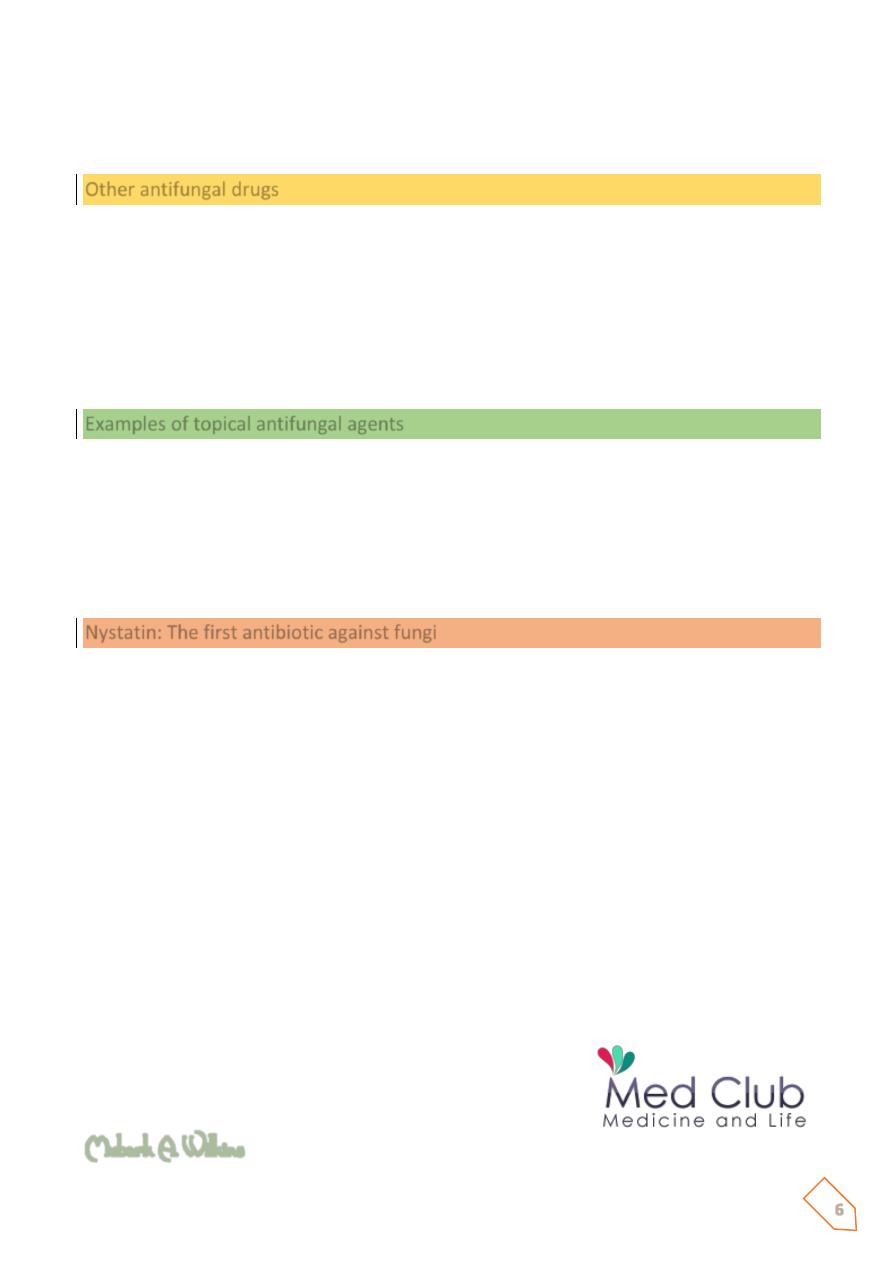
6
• Long term use at high levels leads to accumulation in the body and to iodinism.
• Sodium iodide has been used successfully to treat cutaneous and
cutaneous/lymphadenitis forms of sporotrichosis.
Other antifungal drugs
ⱴ Topical antifungal agents are applied topically, either on the skin, in the ear or eye, or
on mucous membranes to control superficial mycotic infections.
ⱴ Amorolfine is a morpholine derivative that may interfere with the synthesis of sterols
essential for the functioning of fungal cell membranes. It is used to treat
onychomycosis and dermatophytosis.
ⱴ Other topical agents include iodine, amordfine, terbinafine, cidopiroxolamine,
tolnaflate and candicidin
Examples of topical antifungal agents
• Terbinafine is an allylamine antifungal agent available as a topical cream or as tablets.
It decreases synthesis of ergosterol by inhibiting squalene epoxidase.
• Terbinafine iis used in the treatment of dermatophytes and yeasts. It is used in
combination with other antifungal drugs to enhance its efficacy.
• Others are Organic acids: undecylenic acid, caprylic and propionic acid as well as
benzoic acid and salicylic acid.
Nystatin: The first antibiotic against fungi
Like many other antimycotics and antibiotics, nystatin is of bacterial origin. It was isolated
from Streptomyces noursei in 1950 by Elizabeth Lee Hazen and Rachel Fuller Brown, who
were doing research for the Division of Laboratories and Research of the New York State
Department of Health. The soil sample where they discovered nystatin, was from the garden
of Hazen's friends called Nourses, therefore the strain was called noursei. Hazen and Brown
named nystatin after the New York State Public Health Department (now known as the
Wadsworth Center) in 1954.
The two scientists donated the royalties from their invention, over $13 million dollars, to the
nonprofit Research Corporation for the advancement of academic scientific study. Elizabeth
Lee Hazen and Rachel Fuller Brown were inducted into the National Inventors Hall of Fame in
1994.
Mubark A. Wilkins
